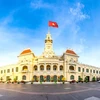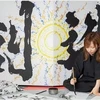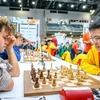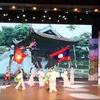An eclectic mix of ceramic statues are on display at the Vietnam National Museum of History in Hanoi in an exhibition that chronicles the historical roots of the Vietnamese culture.
The exhibition titled "Vietnamese Ancient Ceramic Statues" opened earlier this week displaying 70 items dating back 4,000 years with the aim of promoting their cultural value and preservation efforts.
It shows how the materials, forms, technique and decorations of ceramic statues have evolved over time.
Ceramics is the earliest craft in the history of human civilisation. In Vietnam, the oldest ceramic statues trace back to the Phung Nguyen, Dong Dau and Go Mun civilisations 4,000 years ago and take the shapes of humans and animals.
In the feudal periods, the variations in the colour and decoration of ceramic items became so rich. At this time, people did not use ceramics for aesthetic purposes but for daily life and religious practices, said the museum's vice director Nguyen Van Doan.
"Vietnamese ancient ceramic statues have different colours including white glaze and crackle glaze and celadon," he said.
In order to help visitors understand ancient Vietnamese ceramic art, the statues are divided into three groups including daily life, religious and architectural purposes.
"Inspired by nature and daily life, artisans with skillful hands created earthenware, terra cotta and ceramic objects which reflected the Vietnamese people's life and society in different periods of history," Doan said.
Among the ancient ceramic statues, those used as household utensils were most popular because of their roles in life. The statues also present many themes such as humankind, birds and domesticated animals.
"The statues are lively to enhance their reflection of reality. They not only bear spiritual and domestic value but also an aesthetic value," Doan remarked.
Ancient statues used in religious rituals include mainly Buddhist statues and deities in religious folklore. Buddhist statues range between depictions of Sakyamuni, Goddess of Mercy and monks.
The statues were often worshipped in the Buddhist stupa and temples and at ancestral altars. They were considered as symbol of belief and the desire to attain good health, peace, prosperity and happiness.
Domestic ceremics include lamps, caldrons, vessels and flower pots which are used to connect with sacred beings such as the dragon, phoenix, kylin and lion-dog. Mythical creatures, such as kylins, are believed to bring good omens and drive way evil spirits.
Decorative ceramic statues include those depicting dragons, kylins and lion-dogs are often positioned on the roof of religious and imperial monuments such as pagodas, temples, communal houses, temple gates, palaces, tombs and village gates.
The exhibition will run until the end of August.-VNA
The exhibition titled "Vietnamese Ancient Ceramic Statues" opened earlier this week displaying 70 items dating back 4,000 years with the aim of promoting their cultural value and preservation efforts.
It shows how the materials, forms, technique and decorations of ceramic statues have evolved over time.
Ceramics is the earliest craft in the history of human civilisation. In Vietnam, the oldest ceramic statues trace back to the Phung Nguyen, Dong Dau and Go Mun civilisations 4,000 years ago and take the shapes of humans and animals.
In the feudal periods, the variations in the colour and decoration of ceramic items became so rich. At this time, people did not use ceramics for aesthetic purposes but for daily life and religious practices, said the museum's vice director Nguyen Van Doan.
"Vietnamese ancient ceramic statues have different colours including white glaze and crackle glaze and celadon," he said.
In order to help visitors understand ancient Vietnamese ceramic art, the statues are divided into three groups including daily life, religious and architectural purposes.
"Inspired by nature and daily life, artisans with skillful hands created earthenware, terra cotta and ceramic objects which reflected the Vietnamese people's life and society in different periods of history," Doan said.
Among the ancient ceramic statues, those used as household utensils were most popular because of their roles in life. The statues also present many themes such as humankind, birds and domesticated animals.
"The statues are lively to enhance their reflection of reality. They not only bear spiritual and domestic value but also an aesthetic value," Doan remarked.
Ancient statues used in religious rituals include mainly Buddhist statues and deities in religious folklore. Buddhist statues range between depictions of Sakyamuni, Goddess of Mercy and monks.
The statues were often worshipped in the Buddhist stupa and temples and at ancestral altars. They were considered as symbol of belief and the desire to attain good health, peace, prosperity and happiness.
Domestic ceremics include lamps, caldrons, vessels and flower pots which are used to connect with sacred beings such as the dragon, phoenix, kylin and lion-dog. Mythical creatures, such as kylins, are believed to bring good omens and drive way evil spirits.
Decorative ceramic statues include those depicting dragons, kylins and lion-dogs are often positioned on the roof of religious and imperial monuments such as pagodas, temples, communal houses, temple gates, palaces, tombs and village gates.
The exhibition will run until the end of August.-VNA



















